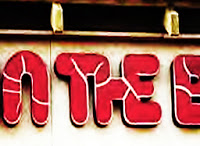Which is Better for Backlit Signs: Cast or Calendered?
Vinyl manufacturers, such as 3M™ and Arlon, produce a broad color selection of translucent cast vinyl films for backlit signage applications. In addition to backlit building signage, other applications include taxi-top signage, mall and airport-terminal advertising, menuboards and canopy fascias.
When subjected to baking heat, cheaper calendered films can shrink and crack.
These films are formulated to uniformly diffuse transmitted light to display uniform color. Many of these cast vinyls match pantone colors or the colors for large nationwide corporate identity programs. These very durable cast films are the top-of-the-line “Cadillac” vinyls available to sign makers.
With improvements in film technology, sign makers have other options. Today translucent calendered vinyl films are now available for “intermediate” applications. These films are designed to withstand the higher service temperatures to which these vinyls are subjected outdoors in the summer heat on the signface of a light box. Don’t expect these films to provide the same service life of cast vinyl. You get what you pay for. When you decide to use a calendered vinyl, you are buying a “Chevy” not a “Cadillac”.
In deciding whether to use either a cast or calendered translucent vinyl film, consider these factors:
- What is the application? For less demanding applications, such as menuboards and directional signs, a calendered translucent vinyl suffices. For long-term, outdoor applications, I would choose cast films.
- What are the durability requirements of the job?
- What are your customer’s expectations?
- What is the budget for the job?
User preference dictates the choice between lower-cost, calendered vinyl versus a premium, cast film. For most applications, you can’t go wrong with cast vinyl.
However, that doesn’t preclude calendered-film usage. Newer generation, calendered, translucent films feature such improvements as color consistency and gauge control. Also, some calendered films provide improved heat stability and up to five year durability.
Because calendered films cost less than cast, they’ve become the film of choice for a wide range of backlit signage. If you use a calendered vinyl, buy one designed for the job. Although calendered films are by their very nature translucent, not all of them are suitable for backlit signage. Lower grade calendered films may look fine during the day, but inconsistencies in color and film gauge readily appear when the sign box lights up.
I’m not saying calendered films are a bad choice for backlit applications. Better varieties have standardized thicknesses. Light-transmission discrepancies cause film-gauge variations, which appear when illuminated.
If color consistency deviates, film can exhibit blotches when illuminated. Plasticizers in cheaper calendered films can migrate to the film surface. If you screenprint or digitally print the film, plasticizing oils inhibit good ink adhesion.
In most cases, an overlaminate should protect the print. Inks tend to be fragile, and overlaminates neutralize such hazards as UV light, air pollution and bird droppings.
Finally, translucent films must be able to withstand high service temperatures. According to Arlon’s Chuck Bules (Santa Ana, CA) on a hot summer day, temperatures inside a light box can easily exceed 150° F. When subjected to baking heat, cheaper calendered films can shrink and crack.



